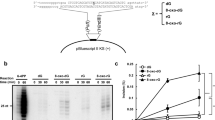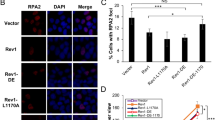Abstract
A superfamily of DNA polymerases that bypass lesions in DNA has been described1,2,3,4. Some family members are described as error-prone because mutations that inactivate the polymerase reduce damage-induced mutagenesis. In contrast, mutations in the skin cancer susceptibility gene XPV5,6, which encodes DNA polymerase (pol)-η, lead to increased ultraviolet-induced mutagenesis7,8,9,10,11. This, and the fact that pol-η primarily inserts adenines during efficient bypass of thymine–thymine dimers in vitro8,12,13, has led to the description of pol-η as error-free. However, here we show that human pol-η copies undamaged DNA with much lower fidelity than any other template-dependent DNA polymerase studied. Pol-η lacks an intrinsic proofreading exonuclease activity and, depending on the mismatch, makes one base substitution error for every 18 to 380 nucleotides synthesized. This very low fidelity indicates a relaxed requirement for correct base pairing geometry and indicates that the function of pol-η may be tightly controlled to prevent potentially mutagenic DNA synthesis.
This is a preview of subscription content, access via your institution
Access options
Subscribe to this journal
Receive 51 print issues and online access
$199.00 per year
only $3.90 per issue
Buy this article
- Purchase on Springer Link
- Instant access to full article PDF
Prices may be subject to local taxes which are calculated during checkout

Similar content being viewed by others
References
Friedberg,E. C. & Gerlach,V. L. Novel DNA polymerases offer clues to the molecular basis of mutagenesis. Cell 98, 413–416 (1999).
Woodgate,R. A plethora of lesion-replicating DNA polymerases. Genes Dev. 13, 2191–2195 (1999).
Johnson,R. E., Washington,M. T., Prakash, S. & Prakash,L. Bridging the gap: A family of novel DNA polymerases that replicate faulty DNA. Proc. Natl Acad. Sci. USA 96, 12224 –12226 (1999).
Ogi,T., Kato,T. Jr, Kato, T. & Ohmori,H. Mutation enhancement by DINB1, a mammalian homologue of the Escherichia coli mutagenesis protein DinB. Genes Cells 4, 607–618 (1999).
Masutani,C. et al. The XPV (xeroderma pigmentosum variant) gene encodes human DNA polymerase η. Nature 399, 700–704 (1999).
Johnson,R. E., Kondratick,C. M., Prakash, S. & Prakash,L. hRAD30 mutations in the variant form of xeroderma pigmentosum. Science 285, 263–265 ( 1999).
Maher,V. M., Ouellette,L. M., Curren,R. D. & McCormick,J. J. Frequency of ultraviolet light-induced mutations is higher in xeroderma pigmentosum variant cells than in normal human cells. Nature 261 , 593–595 (1976).
Myhr,B. C., Turnbull,D. & DiPaolo, J. A. Ultraviolet mutagenesis of normal and xeroderma pigmentosum variant human fibroblasts. Mutat. Res. 62, 341–353 (1979).
Wang,Y. C., Maher,V. M. & McCormick, J. J. Xeroderma pigmentosum variant cells are less likely than normal cells to incorporate dAMP opposite photoproducts during replication of UV-irradiated plasmids. Proc. Natl Acad. Sci. USA 88, 7810–7814 (1991).
Wang,Y. C., Maher,V. M., Mitchell,D. L. & McCormick,J. J. Evidence from mutation spectra that the UV hypermutability of xeroderma pigmentosum variant cell reflects abnormal, error-prone replication on a template containing photoproducts. Mol. Cell. Biol. 13, 4276 –4283 (1993).
Waters,H. L., Seetharam,S., Seidman,M. M. & Kraemer,K. H. Ultraviolet hypermutability of a shuttle vector propagated in xeroderma pigmentosum variant cells. J. Invest. Dermatol. 101, 744–748 (1993).
Masutani,C. et al. Xeroderma pigmentosum variant (XP-V) correcting protein from HeLa cells has a thymine dimer bypass DNA polymerase activity. EMBO J. 18, 3491–3501 ( 1999).
Johnson,R. E., Prakash,S. & Prakash, L. Efficient bypass of a thymine-thymine dimer by yeast DNA polymerase, Pol η. Science 283, 1001–1004 (1999).
Roberts,J. D., Bebenek,K. & Kunkel,T. A. The accuracy of reverse transcriptase from HIV-1. Science 242, 1171–1173 ( 1988).
Osheroff,W. P. et al. The fidelity of DNA polymerase beta during distributive and processive DNA synthesis. J. Biol. Chem. 274, 3642–3650 (1999).
Bebenek,K. & Kunkel,T. A. Analyzing the fidelity of DNA polymerases. Methods Enzymol. 262, 217– 232 (1995).
Washington,M. T., Johnson,R. E., Prakash,S. & Prakash,L. Fidelity and processivity of Saccharomyces cereivisiae DNA polymerase η. J. Biol. Chem. 274, 36835– 36838 (1999).
Perrino,F. W. & Loeb,L. A. Differential extension of 3′ mispairs is a major contribution to the high fidelity of calf thymus DNA polymerase-α. J. Biol. Chem. 264, 2898– 2905 (1989).
Wang,H., Lawrence,C. W., Li,G. M. & Hays,J. B. Specific binding of human MSH2·MSH6 mismatch-repair protein heterodimers to DNA incorporating thymine- or uracil-containing UV light photoproducts opposite mismatched bases. J. Biol. Chem. 274, 16894– 16900 (1999).
McDonald,J. P., Levine,A. S. & Woodgate, R. The Saccharomyces cerevisiae RAD30 gene, a homologue of Escherichia coli dinB and umuC, is damage inducible and functions in a novel error-free postreplication repair mechanism. Genetics 147, 1557–1568 ( 1997).
Kang,X. L., Yadao,F., Gietz,R. D. & Kunz,B. A. Elimination of the yeast RAD6 ubiquitin conjugase enhances base-pair transitions and G.C to T.A transversions as well as transposition of the Ty element: implications for the control of spontaneous mutation. Genetics 130 , 285–294 (1992).
Clairmont,C. A. et al. The Tyr-265-to-Cys mutator mutant of DNA polymerase beta induces a mutator phenotype in mouse LN12 cells. Proc. Natl Acad. Sci. USA 96, 9580–9585 ( 1999).
Kim,S. R. et al. Multiple pathways for SOS-induced mutagenesis in Escherichia coli: an overexpression of dinB/dinP results in strongly enhancing mutagenesis in the absence of any exogenous treatment to damage DNA. Proc. Natl Acad. Sci. USA 94, 13792–13797 (1997).
Kunkel,T. A. & Bebenek,K. DNA replication fidelity. Annu. Rev. Biochem. 69, (in the press).
Nelson,J. R., Lawrence,C. W. & Hinkle, D. C. Thymine-thymine dimer bypass by yeast DNA polymerase ζ. Science 272, 1646–1649 (1996).
Lewis,D. A. et al. Uniquely altered DNA replication fidelity conferred by an amino acid change in the nucleotide binding pocket of human immunodeficiency virus type 1 reverse transcriptase. J. Biol. Chem. 274, 32924–32930 (1999).
Bebenek,K., Joyce,C. M., Fitzgerald,M. P. & Kunkel,T. A. The fidelity of DNA synthesis catalyzed by derivatives of Escherichia coli DNA polymerase I. J. Biol. Chem. 265, 13878 –13887 (1990).
Roberts,J. D. & Kunkel,T. A. in DNA Replication in Eukaryotic Cells: Concepts, Enzymes and Systems (ed. Pamphilis, M. D.) 217 –247 (Cold Spring Harbor Laboratory Press, New York, 1996).
Acknowledgements
We thank W. A. Beard and Y. Pavlov for critical evaluation of the manuscript.
Author information
Authors and Affiliations
Corresponding author
Rights and permissions
About this article
Cite this article
Matsuda, T., Bebenek, K., Masutani, C. et al. Low fidelity DNA synthesis by human DNA polymerase-η. Nature 404, 1011–1013 (2000). https://doi.org/10.1038/35010014
Received:
Accepted:
Issue Date:
DOI: https://doi.org/10.1038/35010014
This article is cited by
-
APOBEC3A drives deaminase domain-independent chromosomal instability to promote pancreatic cancer metastasis
Nature Cancer (2021)
-
Replication origin location might contribute to genetic variability in Trypanosoma cruzi
BMC Genomics (2020)
-
The active site residues Gln55 and Arg73 play a key role in DNA damage bypass by S. cerevisiae Pol η
Scientific Reports (2018)
-
Multinucleotide mutations cause false inferences of lineage-specific positive selection
Nature Ecology & Evolution (2018)
-
Polη O-GlcNAcylation governs genome integrity during translesion DNA synthesis
Nature Communications (2017)
Comments
By submitting a comment you agree to abide by our Terms and Community Guidelines. If you find something abusive or that does not comply with our terms or guidelines please flag it as inappropriate.



